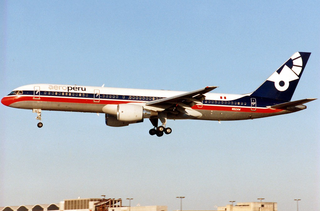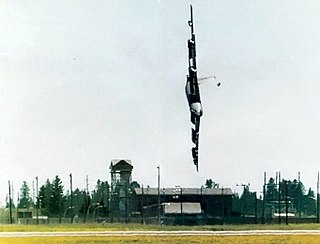
A pitot tube measures fluid flow velocity. It was invented by a French engineer, Henri Pitot, in the early 18th century, and was modified to its modern form in the mid-19th century by a French scientist, Henry Darcy. It is widely used to determine the airspeed of aircraft; the water speed of boats; and the flow velocity of liquids, air, and gases in industry.

The airspeed indicator (ASI) or airspeed gauge is a flight instrument indicating the airspeed of an aircraft in kilometres per hour (km/h), knots (kn), miles per hour (MPH) and/or metres per second (m/s). The recommendation by ICAO is to use km/h, however knots is currently the most used unit. The ASI measures the pressure differential between static pressure from the static port, and total pressure from the pitot tube. This difference in pressure is registered with the ASI pointer on the face of the instrument.

Turkish Airlines Flight 981 (TK981/THY981) was a scheduled flight from Istanbul Yeşilköy Airport to London Heathrow Airport, with an intermediate stop at Orly Airport in Paris. On 3 March 1974, the McDonnell Douglas DC-10 operating the flight crashed into the Ermenonville Forest, outside Paris, killing all 346 people on board. The crash was also known as the Ermenonville air disaster. Flight 981 was the deadliest plane crash in aviation history until 27 March 1977, when 583 people perished in the collision of two Boeing 747s in Tenerife. It remained the deadliest single-aircraft accident until the crash of Japan Airlines Flight 123 on 12 August 1985, and the deadliest aviation accident without survivors until the Charkhi Dadri mid-air collision on 12 November 1996. It remains the deadliest single-aircraft accident without survivors, the second hull loss and the deadliest accident involving the McDonnell Douglas DC-10, the sixth deadliest aviation disaster altogether, and the deadliest aviation accident to occur in France. It is also the deadliest aviation incident that did not involve a Boeing 747.

Aeroperú Flight 603 (PL603/PLI603) was a scheduled passenger flight from Miami International Airport in Miami, Florida, to Arturo Merino Benítez International Airport in Santiago, Chile, with stopovers in Quito, Ecuador, and Lima, Peru. On October 2, 1996, the Boeing 757-23A aircraft flying the final leg of the flight crashed, killing all 70 people aboard.
In aviation, a controlled flight into terrain is an accident in which an airworthy aircraft, fully under pilot control, is unintentionally flown into the ground, a mountain, a body of water or an obstacle. In a typical CFIT scenario, the crew is unaware of the impending collision until impact, or it is too late to avert. The term was coined by engineers at Boeing in the late 1970s.

Aviation safety is the study and practice of managing risks in aviation. This includes preventing aviation accidents and incidents through research, educating air travel personnel, passengers and the general public, as well as the design of aircraft and aviation infrastructure. The aviation industry is subject to significant regulation and oversight.

On August 16, 1987 a McDonnell Douglas MD-82, operating as Northwest Airlines Flight 255, crashed shortly after takeoff from Detroit Metropolitan Airport, about 8:46 pm EDT, resulting in the deaths of all six crew members and 148 of the 149 passengers, along with two people on the ground. The sole survivor was a 4-year-old girl who sustained serious injuries. It was the second-deadliest aviation accident at the time in the United States. It is also the deadliest aviation accident to have a sole survivor.

In aviation, an electronic flight instrument system (EFIS) is a flight instrument display system in an aircraft cockpit that displays flight data electronically rather than electromechanically. An EFIS normally consists of a primary flight display (PFD), multi-function display (MFD), and an engine indicating and crew alerting system (EICAS) display. Early EFIS models used cathode ray tube (CRT) displays, but liquid crystal displays (LCD) are now more common. The complex electromechanical attitude director indicator (ADI) and horizontal situation indicator (HSI) were the first candidates for replacement by EFIS. Now, however, few flight deck instruments cannot be replaced by an electronic display.

The Garmin G1000 is an electronic flight instrument system (EFIS) typically composed of two display units, one serving as a primary flight display, and one as a multi-function display. Manufactured by Garmin Aviation, it serves as a replacement for most conventional flight instruments and avionics. Introduced in June 2004, the system has since become one of the most popular integrated glass cockpit solutions for general aviation and business aircraft.

A pitot–static system is a system of pressure-sensitive instruments that is most often used in aviation to determine an aircraft's airspeed, Mach number, altitude, and altitude trend. A pitot–static system generally consists of a pitot tube, a static port, and the pitot–static instruments. Other instruments that might be connected are air data computers, flight data recorders, altitude encoders, cabin pressurization controllers, and various airspeed switches. Errors in pitot–static system readings can be extremely dangerous as the information obtained from the pitot static system, such as altitude, is potentially safety-critical. Several commercial airline disasters have been traced to a failure of the pitot–static system.

Pilot error generally refers to an accident in which an action or decision made by the pilot was the cause or a contributing factor that led to the accident, but also includes the pilot's failure to make a correct decision or take proper action. Errors are intentional actions that fail to achieve their intended outcomes. The Chicago Convention defines the term "accident" as "an occurrence associated with the operation of an aircraft [...] in which [...] a person is fatally or seriously injured [...] except when the injuries are [...] inflicted by other persons." Hence the definition of "pilot error" does not include deliberate crashing.

A pre-flight safety briefing is a detailed explanation given before take-off to airline passengers about the safety features of the aircraft they are aboard.

Birgenair Flight 301 was a flight chartered by Turkish-managed Birgenair partner Alas Nacionales from Puerto Plata in the Dominican Republic to Frankfurt, Germany, via Gander, Canada, and Berlin, Germany. On 6 February 1996, the Boeing 757-200 operating the route crashed shortly after take-off from Puerto Plata's Gregorio Luperón International Airport. All 189 people on board died. The cause was pilot error after receiving incorrect airspeed information from one of the pitot tubes, which investigators believe was blocked by a wasp nest built inside it. The aircraft had been sitting unused for 20 days, and without pitot tube covers in place for the preceding 2 days before the crash.

An evacuation slide is an inflatable slide used to evacuate an aircraft quickly. An escape slide is required on all commercial aircraft where the door sill height is such that, in the event of an evacuation, passengers would be unable to step down from the door uninjured.

Aircraft emergency oxygen systems or air masks are emergency equipment fitted to pressurized commercial aircraft, intended for use when the cabin pressurisation system has failed and the cabin altitude has climbed above a safe level. It consists of a number of individual yellow oxygen masks stored in compartments near passenger seats and near areas like lavatories and galleys, and an oxygen source, like a centralized gaseous cylinder or decentralized chemical oxygen generator.

Spanair Flight 5022 was a scheduled domestic passenger flight from Barcelona–El Prat Airport to Gran Canaria Airport, Spain, via Madrid–Barajas Airport that crashed just after take-off from runway 36L at Madrid Airport at 14:24 CEST (12:24 UTC) on 20 August 2008. The aircraft was a McDonnell Douglas MD-82, registration EC-HFP. Of the 172 passengers and crew on board, 154 died and 18 survived.

Air France Flight 447 was a scheduled international passenger flight from Rio de Janeiro, Brazil, to Paris, France. On 1 June 2009, inconsistent airspeed indications led to the pilots inadvertently stalling the Airbus A330 serving the flight. They failed to recover the plane from the stall, and the plane crashed into the mid Atlantic Ocean at 02:14 UTC, killing all 228 passengers and crew on board.

Northwest Orient Airlines Flight 6231 was the fatal crash of a Boeing 727 in the eastern United States on December 1, 1974 in Harriman State Park near Stony Point, New York, just north of the New York City area. The Northwest Airlines 727 had been chartered to pick up the Baltimore Colts professional football team in Buffalo in western New York.

Pan Am Flight 799 was an international cargo flight from Los Angeles International Airport to Cam Ranh Airport in South Vietnam that crashed on December 26, 1968, near Anchorage, Alaska. The aircraft involved was a Boeing 707-321C aircraft operated by Pan American World Airways. All three crew members died in the crash.

In aviation, ground deicing of aircraft is the process of removing surface frost, ice or frozen contaminants on aircraft surfaces before an aircraft takes off. This prevents even a small amount of surface frost or ice on aircraft surfaces from severely impacting flight performance. Frozen contaminants on surfaces can also break off in flight, damaging engines or control surfaces.




















